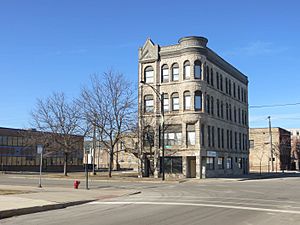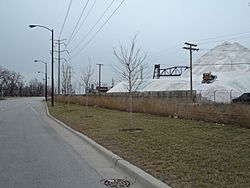South Chicago, Chicago facts for kids
Quick facts for kids
South Chicago
|
|
|---|---|
| Community Area 46 - South Chicago | |

Baltimore Avenue at 92nd Street
|
|

Location within the city of Chicago
|
|
| Country | United States |
| State | Illinois |
| County | Cook |
| City | Chicago |
| Neighborhoods |
list
South Shore
|
| Area | |
| • Total | 3.34 sq mi (8.65 km2) |
| Population
(2020)
|
|
| • Total | 27,300 |
| • Density | 8,174/sq mi (3,156/km2) |
| Demographics 2020 | |
| • White | 2.9% |
| • Black | 75.3% |
| • Hispanic | 20.6% |
| • Asian | 0.4% |
| • Other | 0.9% |
| Time zone | UTC-6 (CST) |
| • Summer (DST) | UTC-5 (CDT) |
| ZIP codes |
parts of 60617
|
| Median household income | $28,504 |
| Source: U.S. Census, Record Information Services - see Discussion page | |
South Chicago, once called Ainsworth, is one of the 77 special areas in Chicago, Illinois. It's a community area located near the southern edge of Lake Michigan, about 10 miles south of downtown Chicago.
This area is shaped like a "chevron" (a V-shape). It is a working-class neighborhood. South Chicago is bordered by East 79th Street to the north and South Chicago Avenue (part of the Chicago Skyway) to the southwest. A small part of East 95th Street forms its southern border. The Calumet River is on its southeast side. South Chicago is seen as a gateway to the Calumet Region. It is one of four Chicago neighborhoods that locals call part of the Southeast Side.
Contents
History of South Chicago
South Chicago started as many small Native American settlements. It later grew into a village. The Pottawatomie people, led by Chief Askhum, lived here. They and other Native groups used the shallow Calumet River area for travel, hunting, and fishing. This was thousands of years before European settlers arrived.
Industrial Growth and New Settlers
After the Civil War, new industries began to grow. A developer named James H. Bowen, known as the "Father of South Chicago," helped change the land. He and others founded "Ainsworth" and other communities. This area was built on wetlands to house European immigrants. These new residents came to work in the industries along the Calumet River. The most important was the North Chicago Rolling Mill Company, built in 1881.
Today, only small parts of the original land and nature remain. Most of the Chicago Lakefront was built on landfill. However, there is a small, hidden beach just north of the former Southworks Site. This beach was once a seasonal home for the Pottawatomie. It was left untouched because of a strong granite rock layer. This rock made it hard to build there at the time. It is the only natural beach left on the Chicago coastline.
Becoming Part of Chicago
The four communities of Ainsworth, which included the Bush, Millgate, Cheltenham/South Chicago, and Calumet, quickly grew into one village. This village was called South Chicago. It became part of Chicago in 1883. Many of the older wooden homes in areas like the Bush and Millgate show how buildings were constructed back then. This also shows that South Chicago was not immediately affected by rules against using wood for homes after The Great Chicago Fire of 1871. After 1883, brick homes started to be built throughout the new neighborhood.
South Chicago became very busy with new immigrants. This was especially true after the World's Columbian Exposition in 1893. The steel mill became U.S. Steel South Works in 1901. It kept attracting immigrants from Ireland, Eastern Europe, Scandinavia, and Italy. In the 1950s, many residents worked in the large steel mills. South Chicago helped make the Chicago area the top producer of steel in the nation. Famous buildings like the Willis Tower and the Hancock Building were built with steel from South Chicago.
Mexican Community in South Chicago
In the early 1910s, Mexicans from different parts of Mexico started to settle in Chicago, including South Chicago. It became one of the first growing Mexican communities in the city. The community faced many challenges. They were not always welcomed in other churches. So, the early Mexican community worked together to build Our Lady of Guadalupe Church. South Chicago's Mexican Patriotic Club held the first Mexican Independence Day (September 16th) Parade in Chicago. It was also celebrated with a carnival.
| Historical population | |||
|---|---|---|---|
| Census | Pop. | %± | |
| 1930 | 56,683 | — | |
| 1940 | 55,090 | −2.8% | |
| 1950 | 55,715 | 1.1% | |
| 1960 | 49,913 | −10.4% | |
| 1970 | 45,655 | −8.5% | |
| 1980 | 46,422 | 1.7% | |
| 1990 | 40,465 | −12.8% | |
| 2000 | 38,596 | −4.6% | |
| 2010 | 31,198 | −19.2% | |
| 2020 | 27,300 | −12.5% | |
Life in South Chicago Today
South Chicago has a large African American population. Other ethnic groups also have strong ties to the area. Our Lady of Guadalupe is the oldest church in Chicago founded by Mexicans. Immaculate Conception and St. Michael's are two churches built in the "Polish Cathedral style". Later, Saint Bronislava also served South Chicago's Polish residents for over 80 years. Now, these churches also have many Latino members. The first Catholic church in South Chicago was St. Patrick, started by Irish Catholics.
Shopping and Local Businesses
Most of the shopping and business happens along Commercial Avenue. You can find many local businesses there. These include clothing stores, furniture shops, and beauty salons. Restaurants offering food from Nigerian to Italian cuisine are also in South Chicago. Even with a slow economy, many "Mom and Pop" stores thrive in South Chicago's neighborhoods. Larger companies and new banks have also come to East 83rd Street, East 87th Street, and Commercial Avenue. Commercial Avenue is also home to many non-profit groups. These include Healthy South Chicago and Centro Comunitario Juan Diego.
Parks and Green Spaces

Bessemer Park is a historic triangular park located between East 89th Street, South Muskegon Avenue, and South Chicago Avenue. It is named after English inventor Henry Bessemer. His process helped create steel. The park was designed by the Olmsted Brothers. They also designed New York City's Central Park and Chicago's Washington Park and Jackson Park. Their work on Bessemer Park started in 1904 and finished in 1905. The park's main building still has much of its original charm. The Bessemer Park Nature and Wildlife Garden is one of Chicago's natural "preserves." It has native plants and animals. Bessemer Park is one of the largest parks on the South Side.
Other parks include Russell Square Park and Eckersall Playground Park and Stadium. New green spaces are also planned, like "Park No. 503." Bicycle paths connect to the Burnham Greenway Trail. This trail links to a large system of greenways in the Calumet Region.
Lakefront Development
Since the late 1970s, South Chicago's shoreline has become more open. East 87th Street now extends to Lake Michigan. The former Southworks site, which was a large steel mill, is being turned into Chicago's newest lakefront park. This area is bigger than the Loop (downtown Chicago). It is being cleaned up and transformed. This project is one of the largest lakefront redevelopment efforts in the 21st century. New homes, shops, and recreation areas are planned. This new park will connect Chicago's chain of parks between South Shore's Rainbow Beach Park and Calumet Park. This fulfills the dreams of famous Chicago planners like Daniel Burnham.
Getting Around South Chicago
South Chicago is not directly connected to the Chicago "L" train system. The closest CTA Red Line station is about 3 miles west. The CTA Green Line is about 5 miles north.
However, South Chicago has four newly rebuilt Metra Electric Line stations. These are Cheltenham and East 79th Street, East 83rd Street, 87th Street, and 93rd Street/South Chicago. The 93rd Street station ends in the heart of the neighborhood's business area. This is the easiest way for people to travel to downtown Chicago. The Chicago Skyway runs along South Chicago Avenue.
Many Chicago Transit Authority (CTA) bus routes also serve South Chicago. These buses make it easy to connect to downtown and other Chicago neighborhoods. Some of the bus routes are:
- N5 South Shore Night Bus
- 6 Jackson Park Express
- J14 Jeffery Jump
- 15 Jeffery Local
- 26 South Shore Express
- 30 South Chicago
- 71 71st St./South Shore
- 79 79th Street
- N79 79th Street Owl
- 87 87th Street
- 95 95th Street
Future Plans for South Chicago
The City of Chicago is working to help South Chicago grow in a good way. This effort aims to create a strong and fair economy in the neighborhood. It is one of the largest projects in the country for making neighborhoods better in a sustainable way. It will guide how the south side develops for the next 25 years.
Chicago's plan will be rated by the United States Green Building Council. This is part of their LEED (Leadership in Energy and Environmental Design) program for neighborhood development.
Redeveloping the US Steel South Works Site
A 30-year plan to develop the former steel mill site was approved in 2010. This project is expected to cost $4 billion. The steel mill operated along the shoreline from 1880 to 1992. Since 1992, the site has been cleaned up. The plan includes extending Lake Shore Drive. Construction was set to begin in 2012.
Education
Chicago Public Schools runs the public schools in South Chicago.
The Roman Catholic Archdiocese of Chicago operates Catholic schools. St. Michael the Archangel School in South Chicago closed in 2018.
Notable People from South Chicago
Many interesting people have come from South Chicago:
- Candy Dawson Boyd: An activist and author who grew up here.
- Andrew Davis: A film director and producer. He directed movies like Under Siege and The Fugitive.
- Nathan Davis: An actor in films and TV. He is Andrew Davis's father.
- Richie Davis: A guitarist and member of the Chicago Catz band.
- Eli Grba: A baseball pitcher for the New York Yankees and Los Angeles Angels. He was raised in South Chicago.
- Joni James: A famous singer who sold over 100 million records. She grew up in South Chicago.
- Chief Keef: A rapper, singer, and record producer.
- Samuel C. Maragos: A politician who represented the Southeast side of Chicago.
- Ed "Chicago Ed" Schwartz: A radio host who worked at Chicago radio stations.
- Donne Trotter: A former member of the Illinois Senate.
Images for kids


